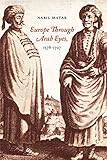Europe through Arab eyes, 1578-1727 / Nabil Matar.
Publisher: New York : Columbia University Press , 2009Copyright date: ©2009Description: xxviii, 313 pages ; 24 cmContent type:- text
- unmediated
- volume
- 9780231141949
| Item type | Current library | Home library | Collection | Call number | Materials specified | Copy number | Status | Date due | Barcode | |
|---|---|---|---|---|---|---|---|---|---|---|
| AM | PERPUSTAKAAN TUN SERI LANANG | PERPUSTAKAAN TUN SERI LANANG KOLEKSI ISLAM-P. TUN SERI LANANG (ARAS 4) | - | DS63.2.E85M38 ki (Browse shelf(Opens below)) | 1 | Available | 00002197562 |
Includes bibliographical references (pages [277]-300) and index.
pt. 1. Popular sources: accounts of Muslim captivity in Christendom -- Elite sources: Muslim ambassadors in Christendom -- Conclusion: Encountering the Dunya of the Christians -- pt. 2. Translations. Letters of Radwan al-Janawy on Muslim captives -- Description of the defeat of the Armada -- A journey from Morocco to Istanbul and back -- Description of the English attack on Cadiz -- Description of Pisa and Florence -- Expulsion of the Moriscos and the miraculous ransoming of Muslim captives -- Letters from Tunis by Osman / Thomas d'Arcos, a convert to Islam -- Letter about Muslim captives converted to Christianity -- Expulsion of the Moriscos -- Description of the world -- Christian attack on Jarbah (Tunisia) in 1510 -- Bombardment of Tripoli, Libya -- Battle accounts -- Euro-Tunisian piracy -- Letter of Mulay Isma'il to the English Parliament -- Letter from a captive in France -- Letters of Bentura de Zari, Moroccan Ambassador under house arrest in London -- Letter of Mulay Isma'il to Philip V -- On Quinine -- Captivity in Malta -- Falling in love in Naples -- Letter from a female captive in Malta.
'Traveling to archives in Tunisia, Morocco, France, and England, with visits to Egypt, Jordan, Lebanon, and Spain, Nabil Matar assembles a rare history of Europe's rise to power as seen through the eyes of those who were later subjugated by it. Many historians of the Middle East believe Arabs and Muslims had no interest in Europe during this period of Western discovery and empire, but in fact these groups were very much engaged with the naval and industrial development, politics, and trade of European Christendom.''Beginning in 1578 with a major Moroccan victory over a Portuguese invading army, Matar surveys this early modern period, in which Europeans and Arabs often shared common political, commercial, and military goals. Matar concentrates on how Muslim captives, ransomers, traders, envoys, travelers, and rulers pursued those goals while transmitting to the nonprint cultures of North Africa their knowledge of the peoples and societies of Spain, France, Britain, Holland, Italy, and Malta. From the first non-European description of Queen Elizabeth I to early accounts of Florence and Pisa in Arabic, from Tunisian descriptions of the Morisco expulsion in 1609 to the letters of a Moroccan Armenian ambassador in London, the translations of the book's second half draw on the popular and elite sources that were available to Arabs in the early modern period.''Matar notes that the Arabs of the Maghrib and the Mashriq were eager to engage Christendom, despite wars and rivalries, and hoped to establish routes of trade and alliances through treaties and royal marriages. However, the rise of an intolerant and exclusionary Christianity and the explosion of European military technology brought these advances to an end. In conclusion, Matar details the decline of Arab-Islamic power and the rise of Britain and France.'--Jacket.
There are no comments on this title.

